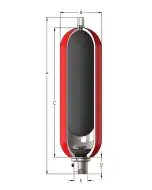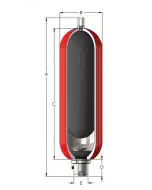Accumulators
Accumulators
- $649.74 $728.00
- $1,025.64 $1,152.40
- $649.74 $728.00
- $653.31 $732.00
- $204.26 $229.50
- $1,224.85 $1,441.00
- $1,224.85 $1,441.00
A1.531005
.531005 Accumulators, Inc 1 Gallon Accumulator, 3000 psi, 1-1/4" Code 61 Split Flange, Buna
$1,201.00- $1,291.15 $1,519.00
- $1,478.15 $1,739.00
- $1,378.44 $1,641.00
- $2,437.80 $2,868.00
- $18,470.50 $21,730.00
- $17,731.85 $20,861.00
- $9,060.15 $10,659.00
- $9,306.65 $10,949.00
- $9,193.60 $10,816.00
- $9,060.15 $10,659.00
A103100
Accumulators, Inc. Accumulator, 10 gallon, 3,000 PSI, 2" NPT Port, Buna N Bladder, Bottom Repairable
$2,331.55 $2,743.00- $2,331.55 $2,743.00
- $2,437.80 $2,868.00
A10310015LXS
Accumulators, Inc Accumulator, 10 Gallon, 3,000 PSI, 1-1/2" CODE 62 SPLIT FLANGE, Low Temp
$4,683.50 $5,510.00- $2,564.45 $3,017.00
- $4,496.50 $5,290.00
- $4,330.75 $5,095.00
- $2,268.00 $2,700.00
- $4,263.60 $5,016.00
- $2,331.55 $2,743.00
- $2,086.56 $2,484.00
- $2,684.30 $3,158.00
- $4,550.05 $5,353.00
- $2,684.30 $3,158.00
- $2,564.45 $3,017.00
- $4,496.50 $5,290.00
- $4,330.75 $5,095.00
- $4,197.30 $4,938.00
- $2,620.55 $3,083.00
- $7,529.30 $8,858.00
- $2,268.00 $2,700.00
- $4,263.60 $5,016.00
- $2,331.55 $2,743.00
- $2,564.45 $3,017.00
- $4,330.75 $5,095.00
- $9,528.50 $11,210.00
- $2,268.00 $2,700.00
- $4,263.60 $5,016.00
- $2,384.25 $2,805.00
- $9,594.80 $11,288.00
- $4,397.05 $5,173.00
|
Reliable, Durable, and Efficient for the Job Whether you run a large industrial plant or a small workshop, we have all types of accumulators for the job. Our accumulators are designed to be highly efficient and durable to ensure reliability for a wide range of hydraulic equipment applications in different industries. From accumulator maintenance accessories and tools designed to simplify installation to hoses, bladder kits, and repair kits for maintenance work, there’s a product for every application. We are a certified seller of hydraulic supplies and accessories, and we know exactly what you need to stay operative and productive. |
Robust and Versatile Accumulators Need accumulators for high-pressure hydraulic systems? Buy our cylindrical accumulators. We bring you a complete and optimized range of hydropneumatic accumulators at G&G Hydraulics. Whatever task you need to be performed, our robust and versatile accumulators can help. These accumulators are designed to make your hydraulic equipment or machinery more convenient to use, and secure, and they’re energy-efficient. We have knowledgeable experts ready to help you select the right type of accumulator according to the specification. Use our live chat feature to get the help you need now. |
Place Your Order Online
Need more detailed information on specific accumulators or other hydraulic parts? At G&G Hydraulics Corporation, we’re here to help. Call us to learn about our high-pressure cylindrical accumulators or shop now to enjoy discounts at checkout and a risk-free guarantee. We have over 700 5-star ratings so you can shop with total confidence.
















































